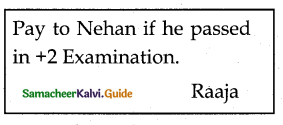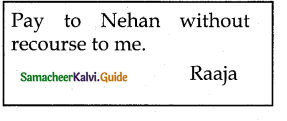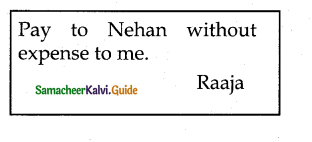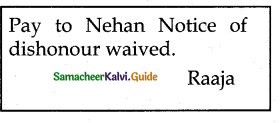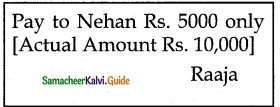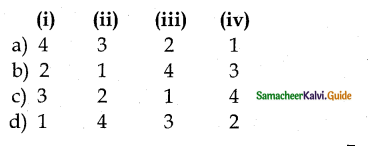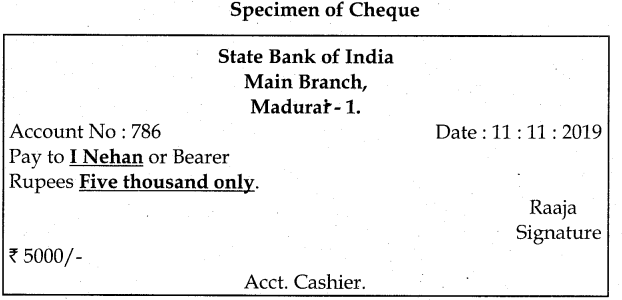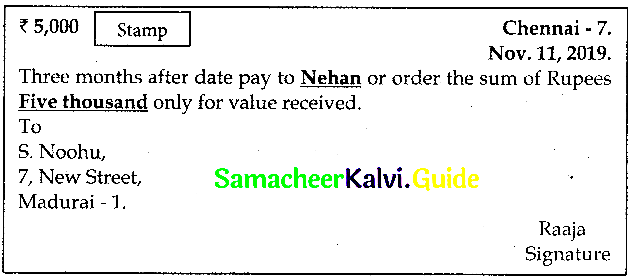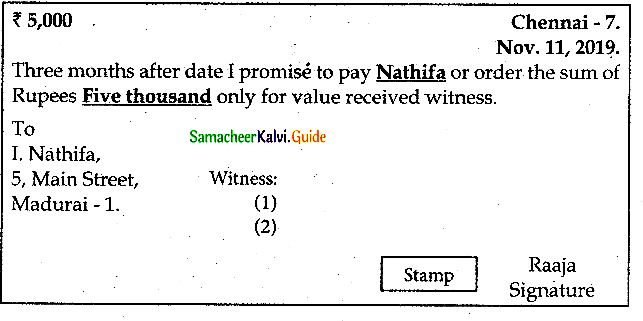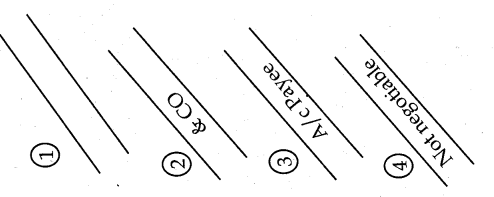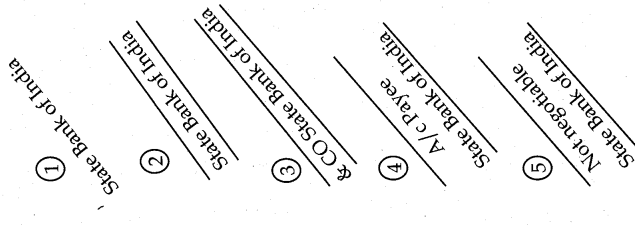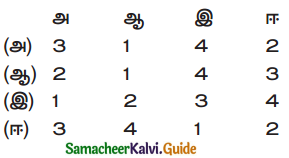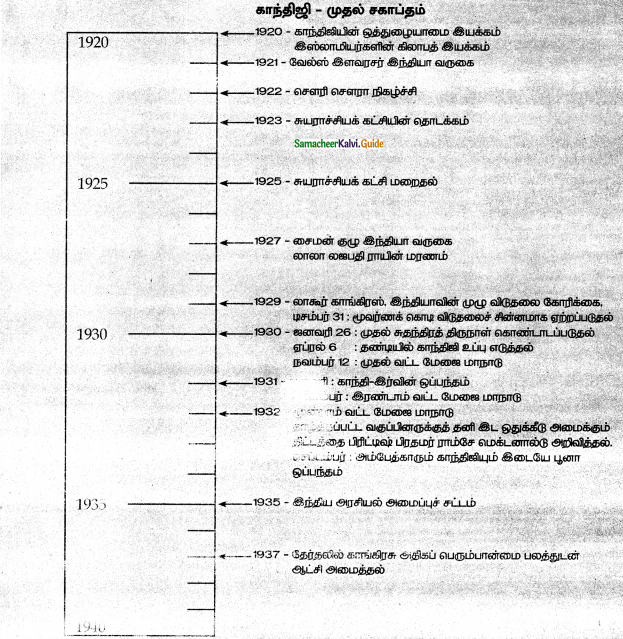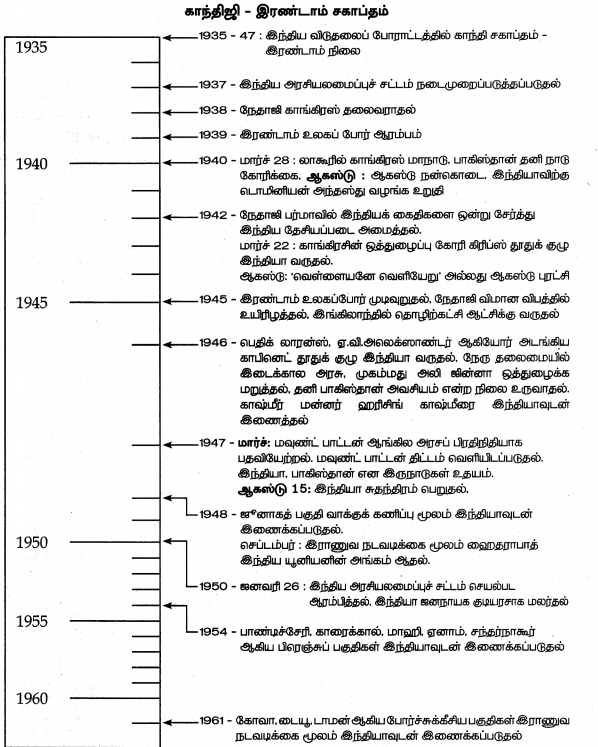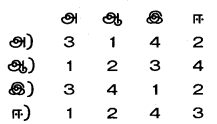Tamilnadu State Board New Syllabus Samacheer Kalvi 12th History Guide Pdf Chapter 6 தேசியவாத அரசியலில் வகுப்புவாதம் Text Book Back Questions and Answers, Notes.
Tamilnadu Samacheer Kalvi 12th History Solutions Chapter 6 தேசியவாத அரசியலில் வகுப்புவாதம்
12th History Guide தேசியவாத அரசியலில் வகுப்புவாதம் Text Book Questions and Answers
I. சரியான விடையைத் தேர்ந்தெடுக்கவும்
Question 1.
முகலாயர் காலத்தில் அலுவலக மற்றும் நீதிமன்ற மொழியாக விளங்கியது எது? (மார்ச் 2020 )
அ) உருது
ஆ) இந்தி
இ) மராத்தி
ஈ) பாரசீகம்
Answer:
ஈ) பாரசீகம்
![]()
Question 2.
பின்வரும் சமூக, சமயச் சீர்சிருத்த நிறுவனங்களை அவை தோற்றுவிக்கப்பட்டதன் கால அடிப்படையில் வரிசைப்படுத்துக.
1. அனைத்து இந்திய முஸ்ஸிம் லீக்
2. அனைத்திந்திய இந்து மகா சபை
3. ஆரிய சமாஜம்
4. பஞ்சாப் இந்து சடை
அ)1,2,3,4
ஆ) 2,1,4,3
இ) 2,4,3,1
ஈ) 4,3,2,1
Answer:
ஆ) 2,1,4,3
Question 3.
லண்டன் பிரிவிக் கவுன்சிலில் இடம்பெற்ற முதல் இந்தியர் ………….
அ) ரஹமத்துல்லா சயானி
ஆ) சர் சையது அகமது கான்
இ) சையது அமீர் அலி
ஈ) பஃருதீன் தயாப்ஜி
Answer:
இ) சையது அமீர் அலி
![]()
Question 4.
கூற்று : 1870இல் வங்காள அரசாங்க ஆணை இஸ்லாமிய தொழில்வல்லுநர் குழுக்களிடையே ஐயங்களை ஏற்படுத்தியது.
காரணம் : அவ்வாணை உருது மொழி பாரசீக அரபி எழுத்து முறைக்குப் பதிலாக இந்தியைக் கொண்டு வந்தது.
அ) கூற்று சரி ஆனால் காரணம் கூற்றை விளக்கவில்லை
ஆ) கூற்று சரி காரணம் கூற்றை விளக்குகிறது
இ) கூற்று தவறு காரணம் சரி
ஈ) கூற்று, காரணம் இரண்டும் தவறு
Answer:
அ) கூற்று சரி ஆனால் காரணம் கூற்றை விளக்கவில்லை
Question 5.
சரியான கூற்றுகளைக் கண்டுபிடிக்கவும்.
கூற்று I : ஆரம்பகால தேசியவாதிகளில் சிலர் தேசியவாதத்தை இந்துமத அடித்தளத்தில் மட்டுமே உருவாக்க முடியும் என நம்பினர்
கூற்று II : இந்து மகாசபை போன்ற அமைப்புகள் எடுத்த முயற்சிகள், அன்னிபெசண்ட் அம்மையாரால் நடத்தப்பட்ட பிரம்மஞான சபையால் வலுப்பெற்றது.
கூற்று III: ஆரிய சமாஜத்தின் சுத்தி மற்றும் சங்காதன் நடவடிக்கைகளில் காங்கிரஸ் பங்கேற்றது இந்து-முஸ்லிம்களிடையே பிரிவை உண்டாக்கியது.
அ) i மற்றும் ii
ஆ) i மற்றும் iii
இ )ii மற்றும் ii
ஈ) அனைத்தும்
Answer:
ஈ) அனைத்தும்
![]()
Question 6.
இரு நாடு கொள்கையை முதன்முதலில் கொண்டு வந்தவர் …….
அ) இராஜாஜி
ஆ) ராம்சே மெக்டோனால்டு
இ)முகமது இக்பால்
ஈ) சர்வாசிர் ஹசன்
Answer:
ஈ) சர் வாசிர் ஹசன்
Question 7.
1937 இல் நடைபெற்ற தேர்தலில் காங்கிரஸ் வெற்றி பெற்றது
அ)12 மாகாணங்கள்
ஆ) 7 மாகாணங்கள்
இ)5 மாகாணங்கள்
ஈ) 8 மாகாணங்கள்
Answer:
ஆ) 7 மாகாணங்கள்
Question 8.
காங்கிரஸ் ஆட்சி முடிவுக்கு வந்த நாளினை முஸ்லிம் லீக் மீட்பு நாளாக கொண்டாடியது.
அ) 22 டிசம்பர், 1940
ஆ) 5 பிப்ரவரி, 1939
இ) 23 மார்ச், 1937
ஈ) 22 டிசம்பர், 1939
Answer:
ஈ) 22 டிசம்பர், 1939
Question 9.
பின்வருவனவற்றைப் பொருத்தி சரியான விடையைத் தேர்வு செய்க.
| பட்டியல் I | பட்டியல் II |
| அ அன்னிபெசண்ட் | 1 அலிகார் இயக்கம் |
| ஆ சையது அகமது கான் | 2. தயானந்த சரஸ்வதி |
| இ கிலாபத் இயக்கம் | 3 பிரம்மஞான சபை |
| ஈ சுத்தி இயக்கம் | 4 அலி சகோதரர்கள் |

Answer:
அ) 3 1 4 2
![]()
Question 10.
பின்வரும் கூற்றுகளிலிருந்து சரியானவற்றைத் தேர்வு செய்க.
i) அலிகார் இயக்கத்தைத் தோற்றுவித்த சர் சையது அகமது தொடக்கத்தில் காங்கிரசை ஆதரித்தார்.
ii) 1909இல்தோற்றுவிக்கப்பட்ட பஞ்சாப் இந்துசபையானது இந்துமதவகுப்புவாத அரசியலுக்கு அடித்தளமிட்டது.
அ) கூற்று (i) மற்றும் (ii) சரி
ஆ) கூற்று (i) சரி (ii) தவறு
இ) கூற்று (i) தவறு (ii) சரி
ஈ) கூற்று (i) மற்றும் (ii) தவறு
Answer:
ஈ) கூற்று (i) மற்றும் (ii) தவறு
Question 11.
எப்போது முஸ்லிம் லீக் நேரடி நடவடிக்கை நாளை அனுசரித்தது?
அ) 25 டிசம்பர், 1942
ஆ) 16 ஆகஸ்ட், 1946
இ)21 மார்ச், 1937
ஈ) 22 டிசம்பர், 1939
Answer:
ஆ) 16 ஆகஸ்ட், 1946
Question 12.
வேவல் பிரபுவிற்குப் பின்னர் பதவியேற்றவர்
அ) லின்லித்கோ
ஆ) பெதிக் லாரன்ஸ்
இ) மௌண்ட்பேட்டன்
ஈ) செம்ஸ்ஃபோர்டு
Answer:
இ) மௌண்ட்பேட்டன்
Question 13.
கூற்று : பிரிட்டிஷ் அரசாங்கம் வகுப்புவாதத்தை வளர்க்கவும் பரப்பவும் பின்பற்றியது தனித்தொகுதிக் கொள்கையாகும்.
காரணம் : மக்கள் இரண்டு தனித்தொகுதிகளாக பிரிக்கப்பட்டதால் வகுப்புவத அடிப்படையிலேயே வாக்களித்தனர். ( மார்ச் 2020 )
அ) கூற்று சரி, ஆனால் காரணம் கூற்றை விளக்கவில்லை
ஆ) கூற்று சரி, காரணம் தவறு
இ) கூற்று மற்றும் காரணம் தவறு
ஈ) கூற்று சரி, காரணம் கூற்றை விளக்குகிறது.
Answer:
ஈ) கூற்று சரி, காரணம் கூற்றை விளக்குகிறது
![]()
Question 14.
பின்வருவனவற்றைப் பொருத்தி சரியான விடையைத் தேர்ந்தெடுக்கவும்.
| அ இந்துமத மறுமலர்ச்சி | 1 M.S.கோல்வாக்கர் |
| ஆ கலீஃபா பதவி ஒழிப்பு | 2 ஆரிய சமாஜம் |
| இ லாலா லஜபதி ராய் | 3 1924 |
| ஈ ராஷ்டிரிய சுயசேவா சங்கம் | 4 இந்து-முஸ்லிம் மாகாணங்களாக பஞ்சாப் பிரித்தல் |
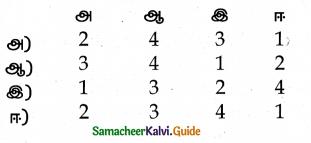
Answer:
ஈ) 2 3 4 1
II. சுருக்கமான விடையளிக்கவும்
Question 1.
கௌராஷினி சபை பற்றி குறிப்பு வரைக?
Answer:
கௌராஷினி சபைகள்:
- கௌராஷினி சபைகள் பசு பாதுகாப்பு சங்கள் எனப்படும்.
- மிகவும் போர்க்குணம் கொண்டவையாக மாறின
- பசுக்களின் விற்பனை அல்லது பசுக்கொலையில் சங்கங்களின் பலவந்தமான தலையீடு இருந்ததாக அறிக்கைகள் கூறுகின்றன.
- பஞ்சாப்பை சேர்ந்த பசுப் பாதுகாவலர்கள் மத்திய மாகாணத்தின் கௌராஷினி சபா செயல்பாட்டாளர்கள்.
Question 2.
இந்து-முஸ்லிம்களிடையே பிரிவினை ஏற்படக் காரணமான ஆரிய சமாஜத்தின் இரண்டு இயக்கங்கள் யாவை?
Answer:
இந்து, முஸ்லிம்களிடையே பிரிவினை ஏற்படக் காரணமாக ஆர்ய சமாஜத்தின் இரண்டு இயக்கங்கள் சுத்தி – மற்றும் சங்கதன் ஆகும்.
Question 3.
ஆகாகான் தலைமையிலான முஸ்லிம் லீக் முன் வைத்த கோரிக்கைகள் என்ன?
Answer:
- பம்பாயிலிருந்து சிந்துப் பகுதியைத் தனியாகப் பிரிப்பது. *
- பலுச்சிஸ்தானையும் அதன் எல்லைகளையும் சீர்திருத்துவது.
- பஞ்சாபிலும் வங்காளத்திலும் மக்கள் தொகை அடிப்படையில் பிரிதிநிதித்துவம்.
- மத்தியச் சட்டமன்றத்தில் முஸ்லிம்களுக்கு 33 விழுக்காடு இட ஒதுக்கீடு.
Question 4.
1923இல் வாரணாசியில் நடைபெற்ற ஆறாவது இந்து மகாசபை மாநாட்டைப் பற்றி குறிப்பு எழுதுக.
Answer:
- 1923 ஆகஸ்டில் வாரணாசியில் நடைபெற்ற இந்து மகாசபையின் ஆறாவது மாநாட்டில் 968 பிரதிநிதிகள் கலந்து கொண்டனர்.
- அவர்களில் 56.7 விழுக்காட்டினர் ஐக்கிய மாகாணத்தைச் சேர்ந்தவர்களாவர்.
- ஐக்கிய மாகாணம், பஞ்சாப், டெல்லி, பீகார் ஆகியவை86.8 விழுக்காட்டுப் பிரதிநிதிகளை அனுப்பிவைத்தன.
- சென்னை பம்பாய், வங்காளம் ஆகிய மூன்றும் 6.6 விழுக்காடு பிரதிநிதிகளை மட்டுமே அனுப்பிவைத்தன.
![]()
III. குறுகிய விடையளிக்கவும்
Question 1.
1921இல் நடைபெற்ற மலபார் கலகத்தைப் பற்றிய காந்தியடிகளின் கருத்து என்ன ?
Answer:
- 1921இல் நடைபெற்ற குருதி கொட்டிய மலபார் கிளர்ச்சியின்போது அங்கு முஸ்லிம் விவசாயிகள் ஆங்கிலேய ஆட்சியாளர்களுக்கு எதிராகவும் இந்து நிலபிரபுக்களுக்கு எதிராகவும் களமிறங்கியது.
- இந்து மகா சபை தன்னுடைய பிரச்சாரத்தை புதுப்பிக்க காரணமாயிற்று \
- அடிப்படையில் அது ஒரு விவசாயக் கிளர்ச்சியாக இருந்தாலும் தீவிர மத உணர்வுகள் கோலோச்சின.
- காந்தியடிகள் இந்நிகழ்வை இந்து முஸ்லிம் மோதலாகவே மதிப்பிட்டார்.
- மலபாரில் நடைபெற்ற நிகழ்வுகளுக்கு முஸ்லிம் தலைவர்கள் பொது மன்னிப்புக் கேட்க வேண்டுமென
காந்தியடிகள் கோரிக்கை விடுத்தார்.
Question 2.
இஸ்லாமியர்களுக்காக மத்தியில் முதலில் அமைக்கப்பட்ட அரசியல் கட்சியின் நோக்கங்களை எழுதுக.
Answer:
அனைத்து இந்திய முஸ்லீம் லீக்கின் நோக்கங்கள்:
- இந்திய முஸ்லீம்கள், பிரிட்டிஷ் அரசிடம் உண்மையுடனும் நன்றியுடனும் நடந்து கொள்ள வேண்டுமென்ற உணர்வை அவர்களிடம் ஏற்படுத்துதல்.
- இந்த அமைப்பின் செயல்பாடுகள் குறித்து அரசுக்கு எழும் தவறான கருத்துக்களை நீக்குதல்
- இந்திய முஸ்லிம்களின் விருப்பங்கள் அரசியல் உரிமைகள் ஆகியவற்றை மேம்படுத்துதல் மற்றும் பாதுகாத்தல்.
- தங்களது தேவைகள், உயர்ந்த லட்சியங்களை கண்ணியமான முறையில் அரசுக்கு தெரிவித்தல்
- இந்திய முஸ்லிம்கள் மற்ற இனத்தவரிடம் எவ்விதபகைமை பாராட்டுவதையும் முன்விரோதம்கொள்வதையும் தடுத்தல் ஆகியவையாகும்.
![]()
Question 3.
1909 ஆம் ஆண்டின் மின்டோ -மார்லி சீர்த்திருத்தங்களின் முக்கியத்துவத்தைக் கூறுக.
Answer:
1909 ஆம் ஆண்டின் மின்டோ -மார்லி சீர்த்திருத்தங்களின் முக்கியத்துவம்:
- அரசபிரதிநிதிகளின் நிர்வாகத்தில் இந்தியருக்கு ஒரு இடம் ஒதுக்கப்பட்டது.
- மைய சட்ட சபையையும் மாநில சட்ட சபையையும் விரிவு படுத்தப்பட்டன.
- வகுப்புவாரி பிரதிநிதித்துவம் அங்கீகரிக்கப்பட்டது. தனித்தொகுதிகள் முஸ்லீமுக்கு வழங்கப்பட்டன.
- தேர்தல் நடந்த முதன் முறையாக அனுமதி அளிக்கப்பட்டது.
Question 4.
வகுப்புவாதம் ஒரு கருத்தியலாக எவ்வாறு வரையறுக்கப்படுகிறது?
Answer:
- பிரிட்டிஷ் இந்திய அரசுவகுப்புவாதத்தை வளர்ப்பதற்கும் பரப்புதற்கும் தனித்தொகுதி என்னும் முதன்மையான நுட்பத்தை நடைமுறைப்படுத்தியது.
- வகுப்புவாதம் என்பது “பிறமதத்தாரோடு பொருள் சார்ந்த பிரச்சனைகளிலும் கூட விரோத போக்கோடு சண்டையிடும் வகையில் ஒரு மதத்தினரை உருவாக்குவது.
- நேருவின் கூற்றுப்படி வகுப்புவாதம் என்பது பிற்போக்குவாதிகள் நவீன உலகத்திற்கும் பொருந்தாத காலாவதியான ஒரு கருத்தை கொண்டிருப்பது என்பதாகும்.
- மற்றொரு அறிஞர் வகுப்புவாதம் என்பது ஒரு குழு குறுகிய நோக்கில் மற்ற குழுக்கள் அல்லது அரசாங்கத்திடமிருந்து வரும் எதிர்ப்பை மடைமாற்றம் செய்யும் நோக்கத்துடன் அணிதிரட்டும் திட்டமிட்ட முயற்சியே ஆகும்.
Question 5.
1927ஆம் ஆண்டு டெல்லியில் நடைபெற்ற முஸ்லிம் லீக் மாநாட்டின் முன்மொழிவுகள் யாவை?
Answer:
1927 மார்ச் 20இல் டெல்லியில் முஸ்லிம்களின் மாநாடு நடைபெற்றது. இம்மாநாட்டில் வைத்த 4 முன்மொழிகள் :
- பம்பாயிலிருந்து சிந்து பகுதியைத் தனியாக பிரிப்பது.
- பலுசிஸ்தானையும் அதன் எல்லைகளையும் சீர்திருத்துவது
- பஞ்சாபிலும் வங்காளத்திலும் மக்கள் தொகை அடிப்படையில் பிரதிநிதித்துவம்.
- மத்திய சட்டமன்றத்தில் முஸ்லீம்களுக்கு 33 விழுக்காடுகள் இட ஒதுக்கீடு ஆகியவையாகும்.
![]()
IV. விரிவான விடையளிக்கவும்
Question 1.
பிரிட்டிஷ் இந்தியாவில் வகுப்புவாதத்தின் தோற்றம் மற்றும் வளர்ச்சி குறித்து ஆய்வு செய்க.
Answer:
பிரிட்டிஷ் இந்தியாவின் வகுப்பு வாதத்தின் தோற்றம் மற்றும் வளர்ச்சி:
- ஆரம்பகால தேசியவாதிகள் சிலர் தேசியவாதத்தை இந்துமத அடித்தளத்தில் மட்டுமே உருவாக்கமுடியும் என்று நம்பினர்.
- 1875 இல் நிறுவப்பட்ட ஆரிய சமாஜத்தின் மூலம் அரசியலில் இந்து மறுமலர்ச்சிக்கான குரல் ஒலிக்கத் தொடங்கியது. ஆரிய சமாஜம் இந்து மதத்தின் உயரியத் தன்மைகளை உறுதியுடன் முன்வைத்தது.
- வடஇந்தியாவின் பெரும்பாலான பகுதிகளில் தோன்றிய பசு பாதுகாப்புத் கழகங்கள் இந்து வகுப்புவாதம் வளர்வதற்கு ஊக்கமளித்தன.
- ஆரிய சமாஜம் போன்ற நிறுவனங்கள் எடுத்த முயற்சிகள் 1891 முதல் அன்னிபெசண்ட் அம்மையாரால் வழிநடத்தப்பட்ட பிரம்மஞான சபையின் மூலம் வலுப்பெற்றன.
முஸ்லிம் உணர்வின் எழுச்சி:
- சர்வபள்ளி கோபால் குறிப்பிடுவது போல, மறுபுறம் இஸ்லாம் அலிகார் இயக்கத்தின் வழியாக தன்னை வெளிப்படுத்திக் கொண்டது.
- பிரிட்டிஷார் அலிகார் கல்லூரியை ஏற்படுத்தி சையது அகமதுகானுக்கு ஆதரவளித்ததும் முஸ்லிம் தேசியக்கட்சி தோன்றவும், முஸ்லிம் அரசியல் கருத்தியல் தோன்றவும் உதவியது.
- வாகாபி இயக்கம் வர்காபிகள் இஸ்லாமை அதனுடைய ஆதித்தூய்மைக்கு அழைத்துச் செல்லவும் அதன் உயிரை உருக்குலைத்துக் கொண்டிருப்பதாக அவர்கள் கருதிய சில மூடப்பழக்கங்களை முடிவுக்கு கொண்டுவரவும் விரும்பினர்.
- வாகாபிகளில் தொடங்கி கிலாபத்காரர்கள் வரையானோர் அடிமட்டச் செயல்பாடுகளில் காட்டிய செயற்முனைப்பு முஸ்லிம்களை அரசியல் மயமாக்குவதில் முக்கியப் பங்காற்றியது.
Question 2.
ஆங்கிலேயர்களின் பிரித்தாளும் கொள்கை இந்திய தேசியத்தில் ஏற்படுத்திய தாக்கம் என்ன? (மார்ச் 2020)
Answer:
கூட்டு இந்திய அடையாளம் ஒன்று உருவாவதைத் தடுப்பதே பிரிட்டிஷாரின் நோக்கமாக இருந்ததால், இந்தியர்களின் ஒருங்கிணைப்பு முயற்சிகளை முறியடிக்கத் தொடங்கினர்.
- பிரிட்டிஷ் ஏகாதிபத்தியம் பிரித்தாளும் கொள்கையைக் கையாண்டது.
- பம்பாய் – கவர்னர் எல்பின்ஸ்டோன், “பழைய ரோமானிய இலட்சியமான ‘Divide et Impera’ (பிரித்தாளுதல்) என்பது நமதாக வேண்டும்” என்று எழுதினார்.
- வகுப்புவாதக் கலவரங்கள் நாட்டின் ஆளுகைக்குச் சவாலாக இருக்கும் என்று தெரிந்திருந்தபோதிலும் பிரிட்டிஸ் அரசாங்கம், வகுப்புவாத கருத்தியல் சார்ந்த அரசியலுக்கும் சட்டப்பூர்வ அங்கீகாரத்தையும், கௌரவத்தையும் வழங்கியது.
- அனைத்துக் கட்சிகளும் இத்தகைய குறுங்குழுவாத அணுகுமுறையைப் பின்பற்றியதால் வடஇந்தியாவில்
இந்துக்கள் மற்றும் முஸ்லிம்களுக்கிடையே பகைமைவளர்ந்தது. இதன் தாக்கம்நாட்டின் பிறபகுதிகளிலும் காணப்பட்டது. - 19ஆம் நூற்றாண்டின் கடைசி பதிற்றாண்டுகளில் ஏராளமான இந்து-முஸ்லிம் கலவரங்கள் வெடித்தன. 1882 இல் ஜீலை – ஆகஸ்டில் தென்னிந்தியாவில் கூட ஒரு பெருங்கலகம் சேலத்தில் நடைபெற்றது.
![]()
Question 3.
இந்து தேசியம், இஸ்லாமிய தேசியம் மற்றும் இந்திய தேசியம் ஆகியவை இந்திய பிரிவினைக்கு சமபங்காற்றியது எவ்வாறு?
Answer:
- கல்வி கற்ற மேல்வகுப்பு இந்துக்கள் தேசிய உணர்வு பெற்று எழுந்தனர்.
- இதனை விரும்பாத ஆங்கிலேயர்கள் நடுத்தர வர்க்க முஸ்லீம்களை காங்கிரஸின் வளர்ச்சியை தடுக்க ஒரு கருவியாக பயன்படுத்திக் கொண்டனர்.
- இது இந்து-முஸ்லீம் இனவாதத்தை தூண்டியது.
இந்து தேசியம்:
- ஆரம்பகால தேசியவாதிகள் சிலர் தேசிய வாதத்தை இந்துமத அடித்தளத்தில் மட்டுமே உருவாக்க முடியும் என எண்ணினர்.
- 1875இல் நிறுவப்பட்ட ஆரிய சமாஜத்தின் மூலம் அரசியலில் இந்து மறுமலர்ச்சிக்கான குரல் ஒலிக்கத் தொடங்கியது.
- ஆரிய சமாஜம் இந்து மதத்தின் உயரிய தன்மைகளை எடுத்துரைத்தது.
- வட இந்தியாவின் பெரும்பாலான பகுதிகளில் தோன்றிய பசு பாதுகாப்பு கழகங்கள் இந்து வகுப்புவாதம் வளர்வதற்கு ஊக்கம் அளித்தது.
- இந்து தேசியவாதிகளில் ஒருவராகத் தன்னை அறிமுகப்படுத்திக் கொண்ட அன்னிபெசன்ட் அம்மையார் தனது கருத்துக்களை கீழ்க்கண்டவாறு குறிப்பிடுகிறார். “பண்டைய மதங்களை புத்துயிர்ப்பு செய்து
வலுப்படுத்தி உயர்த்துவதே இந்தியர்களின் முதற்பணி”. - இது கடந்த காலப் பெருமையுடன் ஒரு புதிய சுயமரியாதையையும், எதிர்காலத்தின் மீதான நம்பிக்கையையும், தேச பற்றுடன் கூடிய வாழ்வின் ஒரு பேரலையாகவும் நாட்டை புனரமைப்பதற்கான தொடக்கமாகவும் உருவாக்கப்படவேண்டும் என இந்து தேசியம் அமைவதற்கான ஊக்கம் கொடுத்தார்.
இஸ்லாமிய தேசியம் :
- இஸ்லாம் அலிகார் இயக்கத்தின் வழியாக தன்னை வெளிப்படுத்திக் கொண்டது.
- பிரிட்டிஷார் அலிகார் கல்லூரியை ஏற்படுத்த சையது அகமதுகானுக்கு ஆதரவளித்ததும் முஸ்லீம் தேசிய கட்சி தோன்றவும் உதவியது.
- வாகாபி இயக்கம் இந்து முஸ்லீம் உறவில் விரிசலை ஏற்படுத்தியது.
- வாகாபிகளில் தொடங்கி கிலாபத்காரர்கள் வரையானோர் அடிமட்ட செயல்பாடுகளில் காட்டிய செயற்முனைப்பு முஸ்லீம்களை அரசியல்மயமாக்குவதில் முக்கிய பங்காற்றியது.
இந்திய தேசியம்:
- இந்திய தேசிய காங்கிரஸ், தேசிய வாதம் மற்றும் சமயச்சார்பின்மையில் உறுதியாக இருந்த போதிலும் அதனுடைய உறுப்பினர்கள் இந்து வகுப்புவாத அமைப்புகளில் செயல்படுவதைத் தடுக்க முடியவில்லை.
- ஆரிய சமாஜத்தின் “சுத்தி” மற்றும் “சங்கதன்” நடவடிக்கைகளில் காங்கிரஸ்காரர்களின் பங்கேற்பு இந்துக்கள் மற்றும் முஸ்லீம்களை பிளவுபடுத்தியது.
- இருப்பினும் நிறைய காங்கிரஸ்காரர்கள் இந்து அமைப்புகளில் ஈடுபட்டாலும் காங்கிரஸ் தலைமை சமயச்சார்பற்றதாகவே விளங்கியது.
- இந்திய தேசிய காங்கிரஸின் மூன்றாவது கூட்டத்தில் பசுவதை குற்றமென அறிவித்து தீர்மானம் நிறைவேற்றப்பட வேண்டும் என காங்கிரஸ்காரர்கள் சிலர் வற்புறுத்திய போது காங்கிரஸ் தலைமை அதனை ஏற்கவில்லை. இவ்வாறாக இந்து தேசியம், முஸ்லீம் தேசியம் மற்றும் இந்திய தேசியம் என இந்திய பிரிவினைக்கு பங்கெடுத்துக் கொண்டது.
![]()
V. செயல்பாடு (மாணவர்களுக்கானது)
1. 1875லிருந்து இந்தியாவில் நடைபெற்ற இந்து-முஸ்லிம் கலகங்களைத் தொகுத்து எழுதுக.
2. மதம் பொதுவெளிக்கு வரலாமா? – என்பது குறித்து விவாதம் செய்க.
12th History Guide தேசியவாத அரசியலில் வகுப்புவாதம் Additional Questions and Answers
1. சரியான விடையைத் தேர்ந்தெடுக்கவும்
Question 1.
அலிகள் இயக்கத்தின் நிறுவனர் ………………
அ) சையத் அமீர் அலி
ஆ) சையது அகமதுகான்
இ) முகமது அலி ஜின்னா
ஈ) லால் சந்த்
Answer:
ஆ) சையது அகமதுகான்
![]()
Question 2.
காங்கிரஸ் முதல் கூட்டத்தில் கலந்து கொண்டவர்கள் ……
அ) 27
ஆ) 72
இ) 92
ஈ) 29
Answer:
ஆ) 72
Question 3.
காங்கிரஸ் முதல் கூட்டத்தில் கலந்து கொண்ட முஸ்லீம் எத்தனை பேர்?
அ) 12
ஆ) 8
இ) 4
ஈ) 2
Answer:
ஈ) 2
Question 4.
பஞ்சாப் இந்துசபாவின் முதன்மை தகவல் தொடர்பாளர் ………….
அ) தயானந்த சரஸ்வதி
ஆ) அன்னிபைசன்ட்
இ) லால் சந்த்
ஈ) ஜவஹர்லால் நேரு
Answer:
இ) லால் சந்த்
![]()
Question 5.
“இந்து முஸ்லீம் வகுப்புவாதம் நடுத்தர மக்களிடையே எழுந்த மோதல்களின் விளையே” என கூறியவர் ……
அ) மோதிலால் நேரு
ஆ) கமலா நேரு
இ) ஜவஹர்லால் நேரு
ஈ) மகாத்மாகாந்தி
Answer:
இ) ஜவஹர்லால் நேரு
Question 6.
1915 இந்துகளின் முதல் அகில இந்திய மாநாடு நடைபெற்ற இடம் ……
அ) டெல்லி
ஆ) டேராடூர்
இ) ஹரித்துவார்
ஈ) பம்பாய்
Answer:
இ) ஹரித்துவார்
![]()
Question 7.
“பழைய ரோமானிய இலட்சியமான ‘Divide et Impera’ (பிரித்தளுதல்) என்பது நமதாக வேண்டும்” என எழுதியவர் ……………..
அ) பம்பாய் கவர்னர் எல்பின்ஸ்டன்
ஆ) சென்னை ஆளுநர் வெலிங்டன்
இ) வங்காள கவர்னர் வில்லியம் பெண்டிங்
ஈ) கர்சன்பிரபு
Answer:
அ) பம்பாய் கவர்னர் எல்பின்ஸ்டன்
Question 8.
அகில இந்திய இந்து மகாசவையின் தமையிடமாகிறது.
அ) டேராடூன்
ஆ) ஹரித்துவார்
இ) சென்னை
ஈ) மும்பை
Answer:
அ) டேராடூன்
Question 9.
இந்து-முஸ்லீம் ஒற்றுமையின் தூதுவர் என சரோஜினியால் புகழாரம் சூட்டப்பட்டவர் …………………..
அ) சர்சையது அகமுதுகான்
ஆ) முகமது அலி ஜின்னா
இ) லாலா லஜபதிராய்
ஈ) ராஜாஜி
Answer:
ஆ) முகமது அலி ஜின்னா
Question 10.
கூற்று : வாகாபி இயக்கம் இந்து-முஸ்லிம் உறவில் விரிசிலை ஏற்படுத்தியது.
காரணம் : வாகாபிகள் இஸ்லாமை அதனுடைய ஆதித்தூய்மைக்கு அழைத்தும் செல்லவும், அதன் உயிரை உடுக்குலைத்துக் கொண்டிருப்பதாக அவர்கள் கருதிய சில மூட பழக்கங்களை முடிவுக்கு கொண்டுவரவும் விரும்பினர்.
i) கூற்று சரி, காரணம் தவறு
ii) கூற்றும் காரணமும் சரி, காரணம் கூற்றுக்கு சரியான விளக்கமாகும்
iii) கூற்று தவறு, காரணம் சரி.
iv) கூற்றுக்கு காரணம் சரியான விளக்கம் இல்லை
Answer:
ii) கூற்றும் காரணமும் சரி, காரணம் கூற்றுக்கு சரியான விளக்கமாகும்
![]()
II. சுருக்கமான விடையளிக்கவும்
Question 1.
இந்து தேசிய வாதிகளில் ஒருவராக அன்னிபெசன்ட் அம்மையார் கூறிய கருத்துக்கள் யாவை?
Answer:
பண்டைய மதங்களைப் புத்துயிர்ப்பு செய்து வலுப்படுத்தி, உயர்த்துவதே இந்தியர்களின் முதற்பணி ஆகும்.
இது கடந்தகாலப் பெருமையுடன், ஒரு புதிய சுய மரியாதையையும், எதிர்காலத்தின் மீதான நம்பிக்கையையும், ஒரு தவிர்க்க இயலாத விளைவாகவும் தேச பற்றுடன் கூடிய வாழ்வின் ஒரு பேரலையாகவும், நாட்டை புணாமைப்பதற்கான தொடக்கமாகவும் உருவாக்கப்பட வேண்டும் “என அன்னிபெசன்ட் அம்மையார் தனது கருத்தாக கூறியுள்ளார்.
Question 2.
வகுப்பு வாதத்தை தடுப்பதில் காங்கிரசும் அரசாங்கமும் தோல்விகண்டது எவ்வாறு?
Answer:
- இந்திய தேசிய காங்கிரஸ் தேசியவாதம் மற்றும் சமயச் சார்பின்மையில் உறுதியாக இருந்த போதிலும் அதனுடைய உறுப்பினர்கள் இந்து வகுப்புவாதி அமைப்புகளில் செயல்படுவதை தடுக்க இயலவில்லை.
- பிரிட்டிஷ் அரசாங்கம் பசுபாதுகாப்பு சங்கங்களை சட்டத்திற்கு புறம்பானவை என அறிவிக்கத்தவறியதும் வகுப்பு வாதத்திற்கு காரணமானவர்களை கைது செய்யத்தவறியதும் மக்களிடம் நம்பிக்கையின்மையை ஏற்படுத்தின.
- பிரிட்டிஷார் வேண்டுமென்றே வகுப்புவாத பிரச்சினையில் காங்கிரஸ்காரர்களை, இந்து வகுப்புவாதம் மற்றும் மறுமலர்ச்சியாளர்களோடு இணைத்து காட்டுவதன்மூலம் வட இந்தியாவில் முஸ்லிம்களிடையே காங்கிரஸ் எதிர்ப்புணர்வுகளை ஏற்படுத்தின.
![]()
Question 3.
1946ல் கிரிப்ஸ்தூதுக்குழுவின் திட்டவரைவுயாது?
Answer:
கிரிப்ஸ்தூதுக்குழுவின் திட்டம்:
- மூன்றடுக்கு கொண்ட கூட்டாட்சி முறையை பரிந்துரைத்தது.
- இக்கூட்டாட்சிமுறையில் டெல்லியில் உள்ள மத்திய அரசாங்கம் ஒருங்கிணைப்பாளராகவும் வெளியுறவு விவகாரங்கள், தகவல்தொடர்பு பாதுகாப்பு மற்றும் ஒன்றிய விவகாரங்களுக்கு மட்டுமான நிதிவழங்குதல் ஆகிய குறைந்தபட்ச வரையறுக்கப்பட்ட அதிகாரங்களைக் கொண்டதாகவும் இருக்கும்.
- இத்துணைக்கண்டத்தின் மாகாணங்கள் 1) இந்துக்கள் பெருபாண்மையாக உள்ள பகுதி 2) ஐக்கிய மாகாணம் 3) முஸ்லிம்கள் அதிகமாக உள்ள எல்லைப்புற மாகாணங்கள் என பிரிக்கப்படும் என்பனவையாகும்.
Question 4.
முஸ்லிம் லீக்கின் “நேரடி நடவடிக்கை நாள்” என்பது யாது?
Answer:
- காங்கிரஸ் தலைவர்களும் ஜின்னாவும் அமைச்சரவைத் தூதுக்குழு திட்டத்தை ஏற்றுக்கொண்டனர்.
- ஆனால் பலவாரங்கள் நடைபெற்ற இரகசிய பேச்சுவார்த்தைக்குப்பின் ஜீலை 29, 1946ல் முஸ்லிம்லீக் அமைச்சரவை தூதுக்குழு திட்டத்தை நிராகரிப்பதாக அறிவித்தது.
- இந்தியாவில் உள்ள அனைத்து முஸ்லிம்களையும் “இதற்கு எதிர்ப்பு தெரிவிக்கும் வகையில்” ஆகஸ்ட் 16 அன்று நேரடி நடவடிக்கை நாளில் ஈடுபடவும் அழைப்பு விடுத்தது.
- கல்கத்தாவில் நான்கு நாட்கள் கலவரங்களும் கொலைகளுமே நடந்தேறின. ஆயிரக்கனக்கான உயிரிழப்புகள் ஏற்பட்டன.
- இதுவரை நாட்டை பிரிவினை செய்யும் முயற்சிக்கு எதிர்ப்பு தெரிவித்துவந்த காந்தியடிகள் முஸ்லிம் லீகின் பாகிஸ்தான் கோரிக்கையை ஏற்றார்.
![]()
III. குறுகிய விடையளிக்கவும்
Question 1.
இந்திய தேசிய காங்கிரஸ் சமய சார்பற்றதாகவே இருந்தது என்பதை நிருபி
Answer:
- ஆரிய சமாஜம் போன்ற இந்து அமைப்புகளால் நிறைய காங்கிரஸ்காரர்கள் ஈடுபட்ட போதிலும் காங்கிரஸ் தலைமை சமய சார்பற்றதாகவே இருந்தது.
- இந்திய தேசிய காங்கிரஸின் மூன்றாவது கூட்டத்தில் பசுவதையை குற்றமென அறிவித்து தீர்மானம் நிறைவேற்றப்பட வேண்டும் என சில காங்கிரஸ்காரர்கள் முயற்சி செய்த போதிலும் காங்கிரஸ் தலைமை அத்தீர்மானத்தை ஏற்கவில்லை.
- ஒரு குறிப்பிட்ட இனத்தைப் பாதிக்கும் தீர்மானம் முன்மொழியப்படும்போது அந்த வகுப்பைச் சார்ந்த உறுப்பினர்கள் எதிர்த்தால் எதிர்க்கும் உறுப்பினர்கள் சிறுபான்மையினராக இருந்தாலும் அத்தீர்மானத்தை நிறைவேற்றக்கூடாது என்ற முடிவுக்கு காங்கிரஸ் வந்திருக்கிறது.
Question 2.
அலிகார் இயக்க நிறுவனரானசர் சையது அகமதுகாளின் செயல்பாட்டை விளக்குக.
Answer:
- சர் சையது அகமதுகான் ஆரம்பத்தில் காங்கிரஸ் காரத்.
- இந்துக்களால் ஆளப்படும் நாட்டில் சிறுபான்மையினரான முஸ்லீம்களுக்கு தக்க உதவிகள் கிடைக்க என்று எண்ணிகாங்கிரஸ் ஆதரவை விலக்கினார்.
- வட இந்தியாவில் பெரும்பான்மையான முஸ்லீம்கள் இவரது வழியைப் பின்பற்றினர்.
- பிரிட்டிஷ்அரசாங்கத்தோடு இணக்கமாகசெயல்படுவதன் மூலம் தனது இணத்திற்கு அரசாங்கத்திடமி பெரும் பங்கினை பெற்றுத்தர இயலும் என எண்ணினார்.
- சர் சையது அகமதுகான் லண்டன் பிரிவு கவுன்சிலிற்கு தேர்ந்தெடுக்கப்பட்ட முதல் இந்தியரான கை அமீர் அலி போன்ற முஸ்லீம் தலைவர்கள் காங்கிரஸ் என்பது இந்து அமைப்பாக பிரதிபலிக்கும் வாதிட்டனர்.
![]()
Question 3.
“அகண்ட இந்துஸ்தான்” – குறிப்பு தருக.
Answer:
- 1924ல் பஞ்சாப் மாகாணம் இந்து முஸ்லிம் மாகாணங்களாகப் பிரிக்கப்பட வேண்டும் என லாலா லஜபதிராய்’ கூறினார்.
- அரசியல் களத்தில் இந்து மத மறுமலர்ச்சிக்கு ஆதரவான சக்திகளைப் பிரதிநிதித்துவப் படுத்திய இந்து மகாசபை அகண்ட இந்துஸ்தான்” என்னும் முழுக்கத்தை முன்வைத்தது.
- இது முஸ்லீம் லீக்கின் தனித்தொகுதிக் கோரிக்கைக்கு எதிராக வைக்கப்பட்டதாகும்.
Question 4.
பிரிவினவாத தேசியத்தின் வளர்ச்சி குறித்த தனது மனவேதனையைகாந்தி எவ்வாறு வெளிபடுத்தினர்?
Answer:
- “தனி மனிதர்களின் எண்ணிக்கையைப் போலவே பல மதங்கள் உள்ளன. ஆனால் தேசியத்தின் ஆன்மா குறித்த விழிப்புணர்வுள்ளவர்கள் மற்றவர்களின் மதங்களில் தலையிட மாட்டார்கள்.
- தங்கள் நாட்டை உருவாக்கிய இந்துக்கள் சீக்கியர்கள், முகமதியர்கள், பார்சிகள், கிறிஸ்தவர்கள் ஆகிய அனைவரும் நாட்டின் சக மனிதர்களே.
- தங்களுடைய நலன்களுக்காக அவர்கள் ஒற்றுமையுடன் வாழ்ந்ததாக வேண்டும்.
- உலகத்தின் எந்த ஒரு பகுதியிலும் ஒரு நாட்டுரிமையும் ஒரு மதமும் ஒரே பொருளைத் தருகிற வார்த்தைகளாக இல்லை.
இந்தியாவில் அவ்வாறு எப்போதுமே இருந்தது இல்லை என பிரிவினைவாத தேசிய வளர்ச்சி குறித்து தனது மன வேதனையை மகாத்மாகாந்தி வெளிப்படுத்தினார்.


